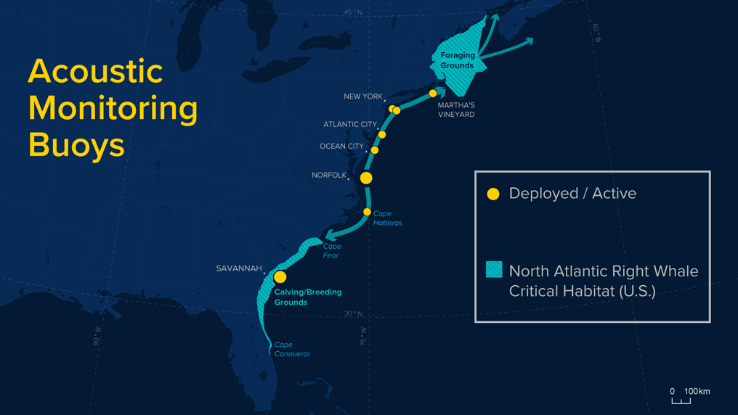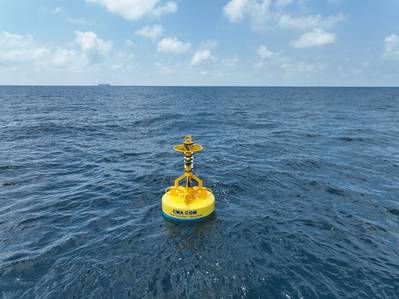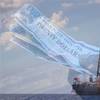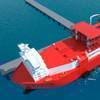New Buoys Aim to Help Protect Whales from Ship Strikes
A network of acoustic monitoring buoys aims to help protect North Atlantic right whales—one of the world’s most critically endangered species—from ship strikes along the U.S. East Coast.
Although North Atlantic right whales are protected under the Endangered Species Act and the Marine Mammal Protection Act, serious threats to their survival abound with only approximately 336 of these great whales remaining on the planet. The installment of the buoys aims to aid in right whale’s survival and will fill a critical gap in monitoring along the East Coast. The new buoys will alert mariners of the presence of whales along heavily trafficked shipping routes near critical U.S. ports
French shipping company CMA CGM Group, in partnership with Woods Hole Oceanographic Institution (WHOI), recently deployed one of the monitoring buoys 39 miles off the coast of Savannah, Ga. This was the partners' second deployment, following the first off the coast of Norfolk, Va., last month. These locations were chosen because the ports are among the busiest in the United States, which often puts ships directly in the path of migrating whales. Other monitoring buoys have already been deployed and are active at other locations along the U.S. East Coast

Mark Baumgartner, project principal investigator and WHOI marine ecologist, said, “This buoy deployment is a great addition to the network of buoys along the East Coast that strive to protect marine life, including the critically endangered North Atlantic right whale. Savannah being a highly trafficked route makes it an important location to use this technology to avoid collisions and to protect the species.”
CMA CGM and WHOI will lead the development of an industry consortium focused on reducing risks to right whales from vessels and supporting the continued operation of the WHOI-developed digital acoustic monitoring buoys.
Heather Wood, CMA CGM Head of Sustainability-North America, said, “At CMA CGM, we act for the planet with a focus on advancing decarbonization and increasing biodiversity within the oceans. The launch of our two CMA CGM Sea Guardian buoys is yet another step in the group’s roadmap to preserve the health of the ocean and to slow climate change ensuring that future generations of terrestrial and aquatic species will be able to call the planet home.”
On the East Coast of the United States and Canada, CMA CGM requires its vessels to reduce their speed to a maximum of 10 knots in certain areas recognized as breeding grounds for cetaceans. On the West Coast, CMA CGM has voluntarily committed to the “Green Flag” speed-reduction program that was introduced in the sanctuary near the Santa Barbara Islands.
In addition, the CMA CGM Group is participating in a variety of projects designed to revolutionize marine mammal protection through the development of innovative technology. Examples include REPCET, a collaborative system based on the density of the mesh created by navigation that allows merchant ships to receive and transmit alerts on whale positions in real time, as well as SEA DETECT, a European project that tests innovative solutions for detecting cetaceans and floating objects at sea. CMA CGM has also joined the LIFE-PIAQUO consortium, whose objective is to develop and test various equipment to reduce the noise of maritime traffic and its impact on aquatic biodiversity.














